Story – Chris Hector & Photos – Roz Neave
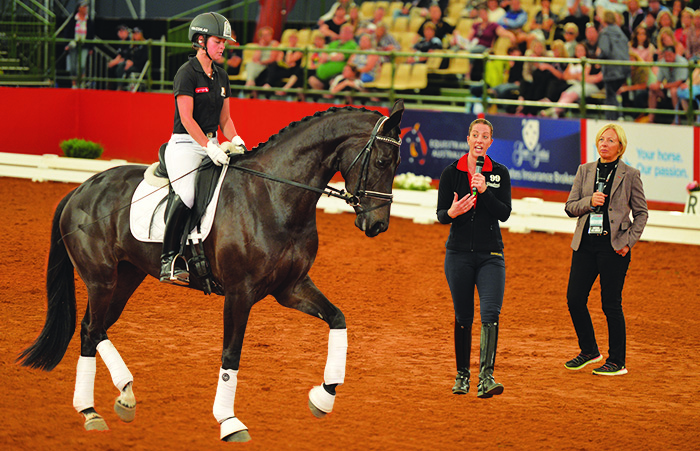
I must confess I was a little apprehensive before the Charlotte Dujardin Master Class. Of late there has been a concerted push to celebratize our top dressage riders, the once serious debate at the Global Dressage Forum has seemingly given way to the equine equivalent of days of our lives, and I feared that the British super star might just switch into a well practiced routine to keep the masses giggling…
Fears unfounded, despite a couple of cringe-worthy attempts to re-hash old anecdotes (in case you are the only person in the equestrian universe who doesn’t know why Charlotte is called ‘Edwina’ and Carl ‘Grand-dad’, it is because when she first started riding, Charlotte had ‘showie’ hands… hence Edward – Edwina – Scissorhands, and in retaliation, she started calling her mentor Grand-dad, at every opportunity. Hilarious the first fifteen or twenty times you hear it…)
Charlotte has many great strengths, an ice cool head for competition, a natural balance and empathy, and most of all, a ferocious attention to detail, to doing simple things perfectly, and she wasn’t about to tell her students how good they were, quite the reverse.
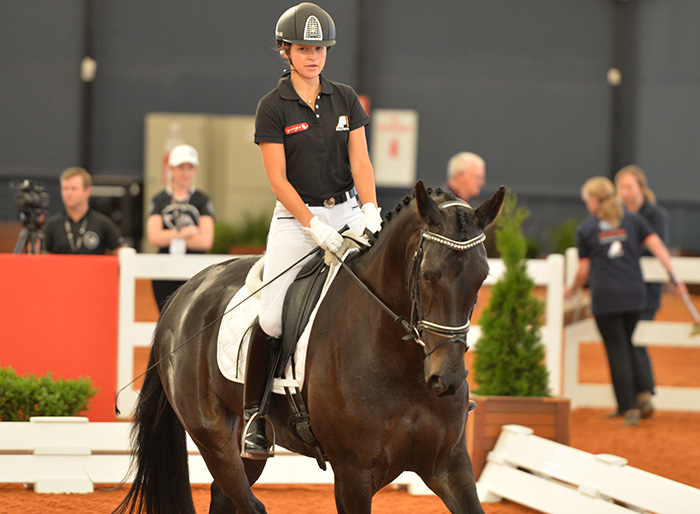
As always, the atmosphere makes it impossible to conduct a ‘normal’ lesson, although Lilah Nieuwland’s gorgeous four year old, Bloomfield Fürstin Romance was trying her heart out to be good, and Charlotte was sympathetic:
“There is so much atmosphere, just try to give her a nice time and build her confidence, let her look, pat her on the neck. You don’t have to keep her round and on the bit, and don’t stretch young horses, it’s not safe – keep the contact until they relax.”
Charlotte was being assisted by her first mentor, British rider and judge, Judy Harvey, who made the point: “dressage horses are not meant to be police horses, if they go around like old Dobbins with no adrenalin, they are no good to us.”
“Don’t do too much with young horses,” Charlotte stressed, “I do 20 minutes with most four year olds. Walk, trot, canter, on the bit, straight. Educate them in a really easy way, relaxed trot, easy canter, work on steering and control, and work from there. With a bigger horse, like this one, I’d do less, because they wear out quicker.”
Judy warned: “We see fabulous three and four year olds, they do well in Young Horse classes, but they are often really stressed. If we want them to have long careers, we should look after them.”
Romance decides to do a little rear. Charlotte is laughing: “That’s the fun of a four year old, the excitement of possibly being bucked off. She’s afraid, you’ve got to give her confidence, you relax and let her relax. Drop your whip, pat her, she is starting to relax and getting more swing.”
Next, the main message of the session
On to the main message of the session: transitions.
“With a four-year-old, hundreds and thousands of transitions all through the session. Transitions get them listening, make them stronger. If you look up you’ll be able to ride her in a straight line…”
But not just any transition. Forward, round, and into the transition.
“That was a really bad transition from you. Now it’s a case of pat the horse, slap the rider. Her job is to educate the horse, and she just rode it like an Advanced horse. If we see this horse in the future with bad transitions, blame Lilah.”
And the trot / canter transition came in for more criticism:
“That’s a showjumping transition, rising trot to canter, that’s cheating!” And the transition down: “Another sloppy transition, not making the horse more round, not making it more forward, just pull on the rein. Round and forward to trot, that’s a transition. No more sloppy disgusting transitions, don’t be a lazy rider.”
“Lilah should spend most of her time doing basic transitions, until she can go up, down, without the horse’s neck coming up, she must be strict with herself. Was that good enough? No. Do it again.”
“When I first saw Lilah two days ago, the mare trotted at snail’s pace, she would have had time faults in a test. When she told me the horse was ‘hot’ I almost fell over. She is much better today but it is true, when people ride young horses all most of them want to do is go slow. You have to ride them forward and that is actually easier than holding them back.”
But it was still the transitions that Charlotte wanted to emphasise:
“What did you think of that transition?”
“Her head came up.”
“Did you do anything? No. You must be strict and ride every transition. Make the transition forward to walk, don’t fall in a heap, don’t shorten the reins you cheat!”
“You’ve got to think of dropping her neck down, forward with the legs, stretch down, round, keep round, and forwards to trot. Yes! We’ve made it.”
And now, Romance was invited to stretch: “Now you can see she wants to stretch. This is why we don’t worry about stretching at first – after ten or fifteen minutes, they are going to want to stretch…”
Next rider follows
The next rider into the ring was Bonnie Kingsley and a six year old Friesian stallion, Braggo of Terrarossa, imported from Holland twelve months ago. In The Netherlands, he had been a harness horse, now he was being trained for dressage.
It seems Charlotte is not a breed snob: “This horse looks really fun – how good will his piaffe / passage be with his pushing hind legs and great front legs. However he has got a tricky neck, so up and naturally on the bit, we have to work on getting him to drop and stretch, so the neck is not so tight.”
Judy had worked with the stallion the previous day “I hope he settles a bit quicker today. Friesians are tricky in neck because they are carriage horses and get a strong under neck.”
Charlotte asks Bonnie to ride a leg yield from the centre line, but is unhappy with the horse taking charge of the movement: “First ride a diagonal line, A to S, ride the diagonal straight first, then ask him to go sideways. There she let the horse fall sideways rather than going forward and sideways. You have to stay in charge of how much sideways. The whole time, he is trying to take over, trying to get to the wall quicker than Bonnie wants him to.”
Judy emphasises the point: “He wants to rush sideways, most horses want to hug the track, this exercise gives the rider control.”
And while the visiting star was getting ready to ride, Judy gave a little insight into why she has been so successful: “Charlotte is very self-disciplined, the works out very hard at the gym, in riding she is obsessed her attention to detail. At first, that could go over the top, but she is learning that a little progress is still progress. She is actually being quite kind to the riders today, it’s lucky it’s not two days or she could get quite strict.”
“Watching Charlotte with the stallion, you can see how much deeper she rides into the corners, that’s discipline. That’s the job of the rider to maintain suppleness and contact. Often when the rider says the horse is ‘lazy’, it’s actually the rider who has made the horse dull. You’ve got to allow the horse to go forward, the contact is there but forward…”
And Braggo was learning to go for a bit of a burn:
“When I touch him with my leg – FORWARD – straight away. See how much quicker he is now after three times. If you leave your leg on them all the time, they get more and more dead and lazy. Touch and forward. They have to react from the smallest aid, when you get to Grand Prix, you just want to steer.”
“I’m going to try a flying change. It doesn’t matter if it doesn’t look pretty at first, as long as he does one side to the other. Never tell them off if they don’t do it perfectly or they will become afraid of doing changes. Okay, he just changed in front, how you start doesn’t matter, at home I’d use a little whip to bounce him through.”
Charlotte might advocate using a whip for specific purposes, but on the whole she was anti-whip, as she explained to the next rider, Edwina Hutton-Potts with Heathmont Echo. “Riders ride all season at home with the whip and they get good marks, then when they get to the National Championships, where they aren’t allowed the whip, it all falls apart, they come out of the test knackered, red, sweaty and exhausted, and the horse is as dry as a bone. ‘Oh, I think he has a fever…’ There’s no fever, he knows there’s no whip, and he’s having a jolly time. You must be able to get a response from your leg. Click and kick and let go of the reins, that’s most important, let go. GO!”
“Is that your YEE HA? Jesus Christ, you aren’t going to win no races.”
And in truth, dear old Heathmont Echo was well in charge of the situation, but he did finally decide to go forward a little more energetically.
“This is your working canter. You’ve been stuck at snail pace, never out of first gear. Now you have a much nicer canter with more suspension, but it will take months to learn, KICK and GO!”
“Make him go forwards and back, and no he mustn’t take over and over collect, as soon as you feel him behind your leg, ride him straight out. YEE HA is about having the horse in front of you. He’s laughing at you, you haven’t got a whip so I don’t have to do it. He’s very cheeky. You’ve got to learn to use your legs, and to relax your leg in between, don’t leave your legs on… and don’t try and whip with the reins, it’s not a good look.”
“Keep doing transitions because then he is thinking, ‘what’s next?’, rather than round and round, that’s boring for him and boring for me. If you take your legs off and he stops, give him a jolly good poke and say, ‘stay in front of me.”
Time for Edwina to ride a few changes, and immediately Charlotte spotted a problem: “The left to right change is much straighter. I would put the changes on the wall, so that when he goes to swing his bottom out, it is into the wall. We do all our changes on the wall until a week before we go to a competition and then when you do them on the diagonal, they are straight and forward.”
When Edwina tries to make a walk trot transition, the gelding starts a sort of shuffle piaffe: “He’s thinking piaffe, there’s nothing worse than when you pick up the reins and they come back at you and try and piaffe – especially when you know you have to do collected walk. You’ve got to go home and work on walk / canter, not thinking piaffe. Be strict with yourself… you are not allowed to walk like that.”
“Our horses go out hacking and they learn to walk, they have to march to keep up with the older horses, and hacking out, also they get used to different surfaces.”
“This horse is lazy, don’t go to sitting trot until he is in front of your leg. When he is forward, his mouth will be closed. He’s lazy, that’s why his mouth is open. You mustn’t pull back with hands like you are carrying handbags, when you turn your hand over like that, then you lock your wrist, your thumbs must be on top – not on the side. When your thumbs are on top, then you can move your arm…”
The next rider into the arena was Queenslander, Nicole Tough riding Borsato, a Dutch dressage horse that was imported to Australia in October last year. Charlotte confiscates the whip: “I want t see the true Nicole, I won’t let her cheat. Nicole said she’d like to work on her pirouettes, so that’s what we’ll do.”
“Now canter, shorten the reins, don’t rock – belly button forward. Start with travers, and ask yourself, is he on my leg? Is he round and supple?”
Once again, Charlotte was quick to correct the rider’s position. Nicole was hanging to the outside on the movement: “The rider must have her weight in the direction she is going not hanging out behind. Ask for more bend but don’t cross your hand over the horse’s shoulder to get that bend. Go forward and back in travers, keep the horse’s shoulders to the wall. Now do a leg yield all the way over the arena, leg yield rather than half pass, leg yield gets them more sideways and looser in your hand. Now travers on a ten metre circle, the horse’s front legs should be on a ten metre circle, the hind legs on an eight metre circle.”
The horse decides to make the circle even tighter…
“He took over. Keep him out with your inside leg, canter bigger and faster.”
“It’s a problem, horses taking over. Valegro has been doing Grand Prix for four years, he knows where every movement goes, so how to stop him taking over? Don’t ride those movements at home, only at the show, and then he never learns to take over.”
Time to try the pirouette on the centre line:
“Come down the centre line, a tiny bit shoulder fore, now turn, six steps – okay, not too bad, a little big. The first two strides have to be short, now think bigger and ride out. So many riders look down, and they don’t finish the pirouette, look up.”
“Now trot and he needs to be rounder and looser in your hand, really get him forward – ROAD RUNNER – be brave. He has to push, you’ve got to learn to ride forward and not ride so slowly. This horse looks so much more expressive when he’s forward, much bigger lift and reach. You can get that power and expression by being brave and riding forward.”
The next combination was 14 year old Tayla Desmet riding 14 year old Rodrigo, Maree Tomkinson’s Grand Prix horse. As Charlotte goes in search of her helmet, Judy Harvey critique’s Tayla’s warmup. “It’s so depressing for the horses when the rider just pulls their head in. You can see Tayla trying to ride from the front to the back. Perhaps she hasn’t got the core strength yet to ride from the back to the front.
Charlotte is in the saddle:
“It’s not always the easiest to ride a trained horse, you have to learn someone else’s aids. A horse like this has a few habits, they like to take over. He knows – she doesn’t… but he’s got me in the saddle now.”
“He’s a bit slow off my leg aid, he has to be hotter off my leg…”
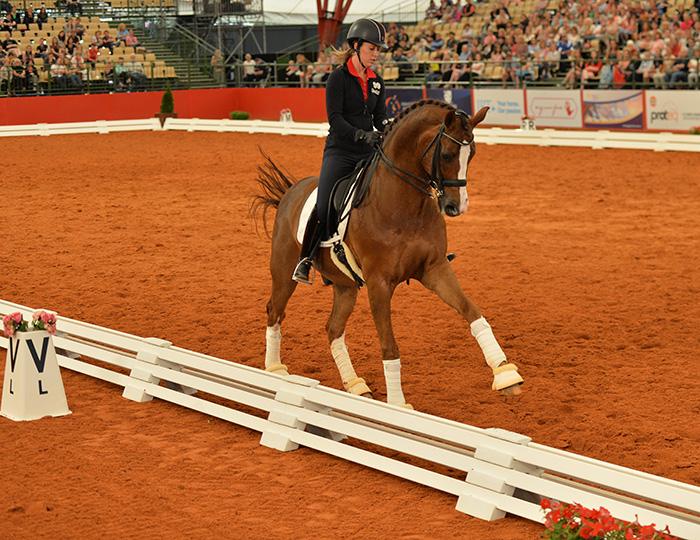
Charlotte tries some two times and is not happy, “he curled to the left and got down. Dressage has changed. Seven or eight is not good enough, you have to ride for a nine or a ten. I used to dream about getting 70s, now I need high 80s to stay on top. I have to take as much risk as I can without making mistakes. At Caen, I had a really good Grand Prix. In the Special he felt so good warming up that I went for more, and made three big mistakes. I’d gone for too much, luckily it didn’t cost me a medal, but I did less in the Freestyle…”
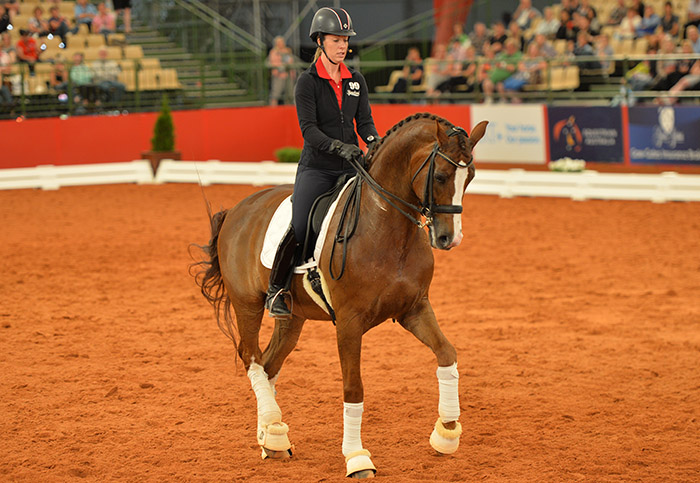
Back to dear Rodrigo:
“This piaffe is just jogging on the spot. At home I never train piaffe like I ride it in the test. Train it forward at home. So many horses get stuck in piaffe, they take over.”
“Now I put a little passage in the trot and he looks like a Grand Prix horse, and I am not doing it with my reins, I am literally doing it with my seat, my legs hang loose and I let him do the work. If I lose it, then I do another transition, that way I stay in control.”
The next horse into the ring, Ambassi with Shanon McKimmie was a breath of fresh air, the big gelding was actually on the aids and in front of the rider’s leg. Shanon has been working for a long time for Mary Hanna – it shows.
Shanon wants to work on the zig zag, and that’s what they do. “When I am working on the zig zag, I always do it on the wall, then I can see how far I come over, and how far back. I do it in leg yield because it is easier to go sideways. This movement is scored times two in our test.”
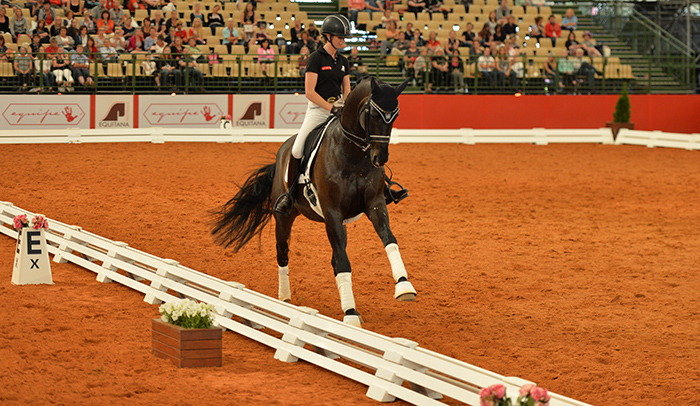
Shanon sets off down the wall and only just squeezes the movement in (it is a very big horse): “Because you let it get longer, you can’t fit it in, keep the canter collected, keep it bouncy, and you have got to look up where you are going.”
This time the zig zag fits.
“Now do it in half pass. Make it bigger in the half pass, get expression, not speed – there, that’s lovely expression.”
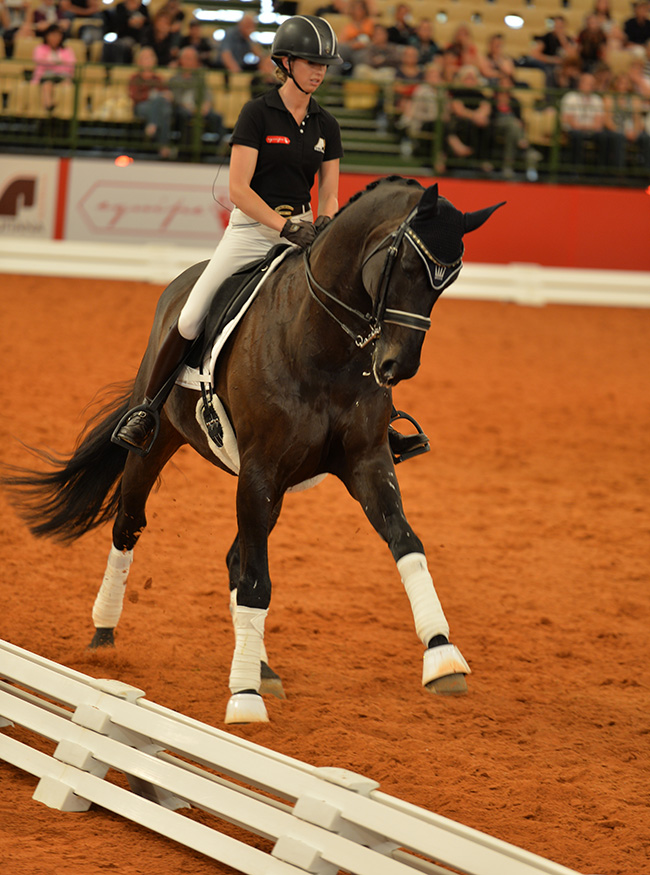
The pair finish with some lovely ones, and some very very nice twos. It is so nice to see a young horse that has been so honestly trained, but just because you have finished, that doesn’t mean you can relax: “That was a bad canter / walk transition. That was not good. I’m watching, I’m watching…”
She was. Like a hawk, noting every little detail. Did she say anything we hadn’t heard over and over before? No – but she took the work to a new level of concentration and focus. That was a lesson worth learning.
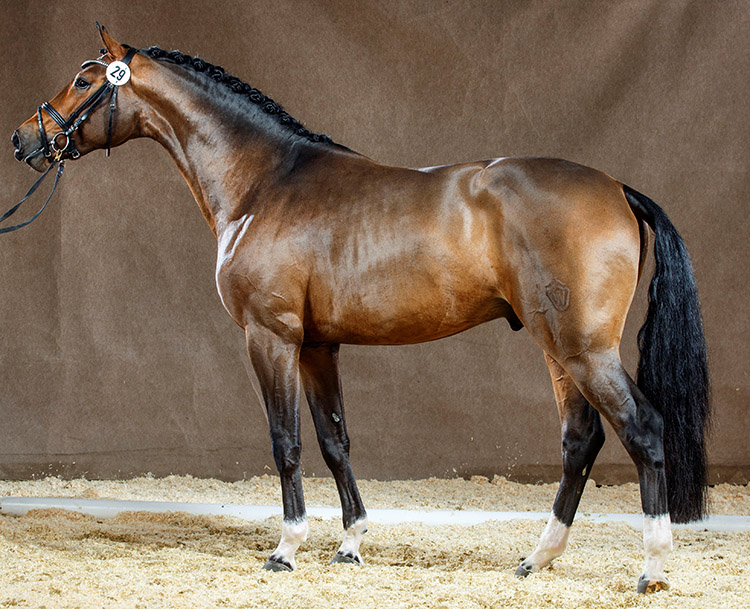 The magnificent stallion, Rock Springs, is available in Australia from International Horse Breeders: www.ihb.com.au
The magnificent stallion, Rock Springs, is available in Australia from International Horse Breeders: www.ihb.com.au


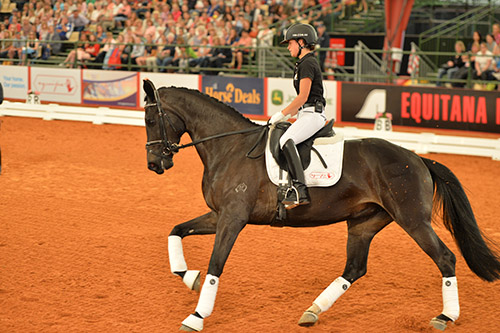
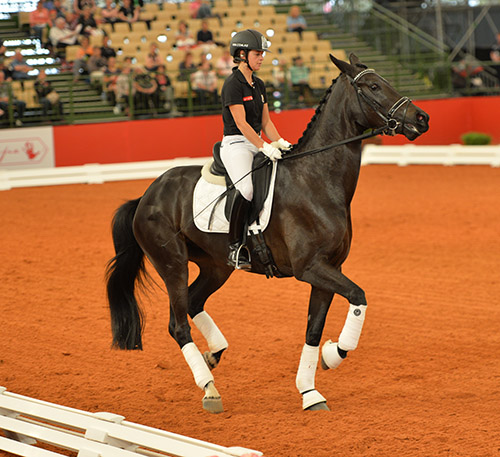
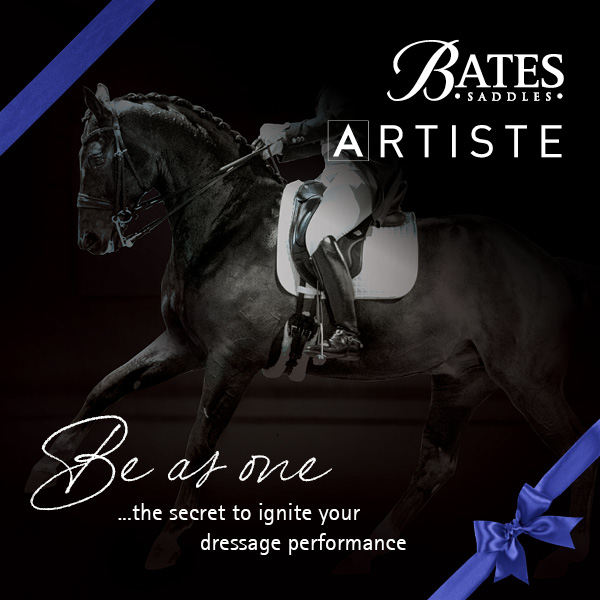
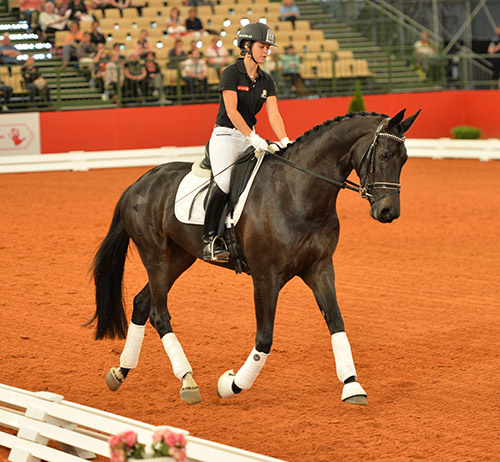
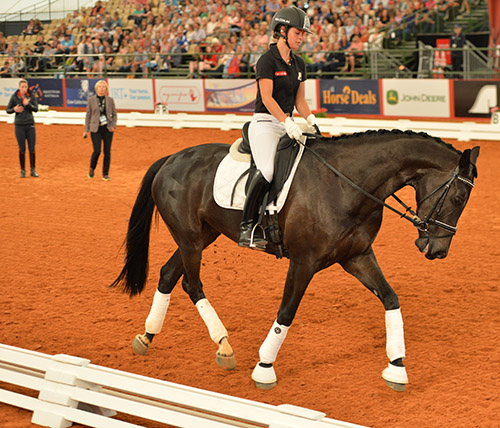
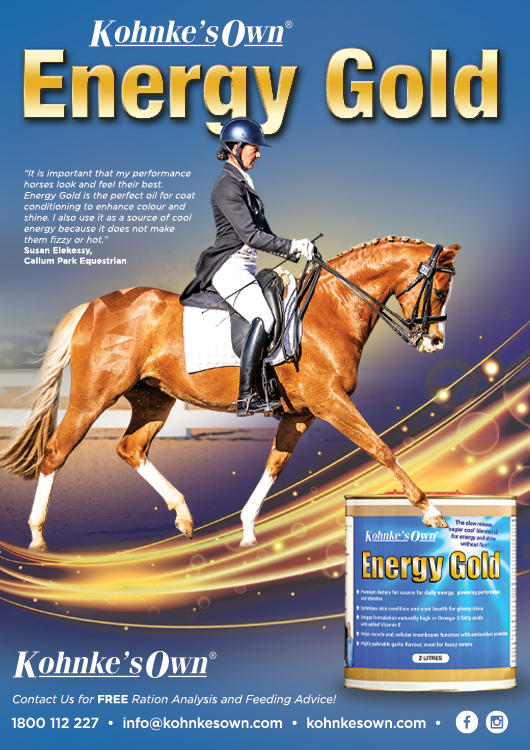
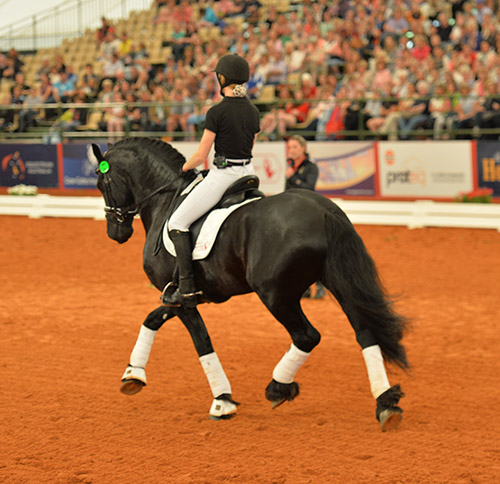
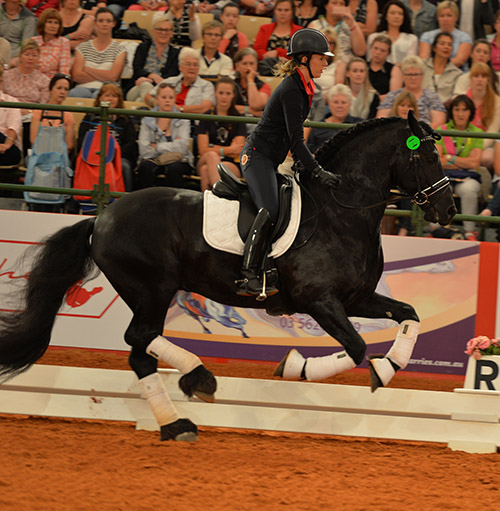
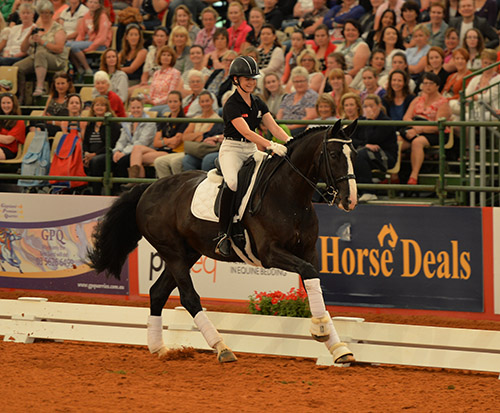
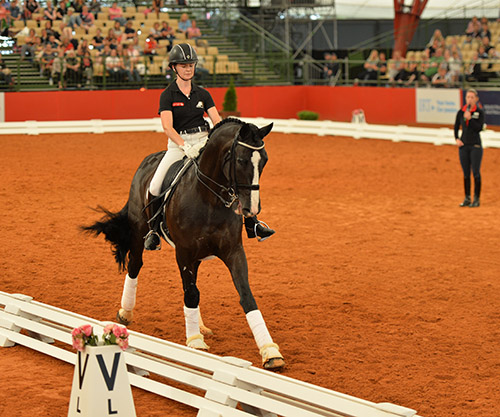
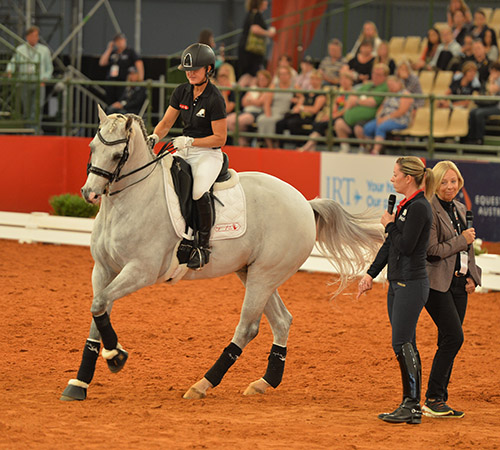
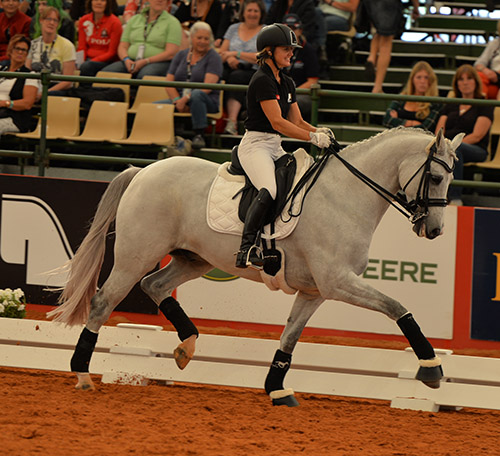
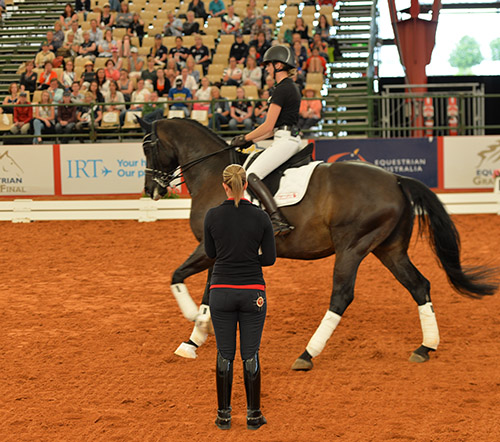
Very informative written recording of lessons, highlighting the different areas that each rider needs to work on to improve. Giving me further information on what I should be expecting from myself as a rider to enable my horse reach his potential.